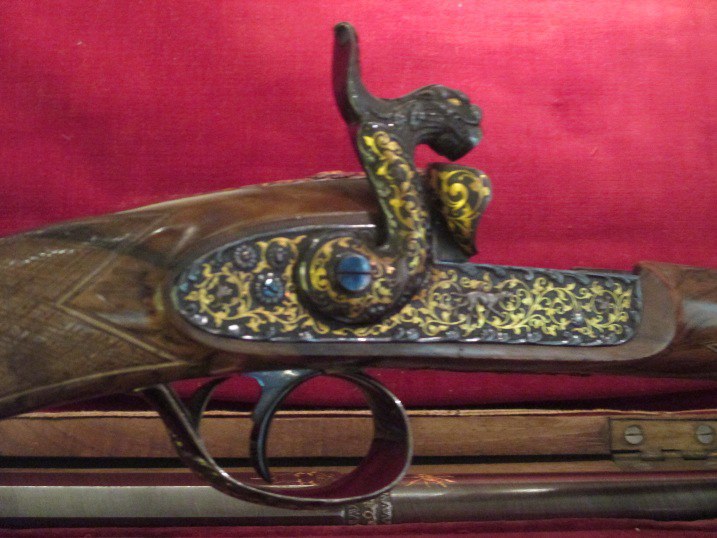Luxury shotgun by Ignacio Ibarzabal

Ignacio Ibarzábal Iriondo, son of Gabriel Benito Ibarzábal y Pagoegui, was one of the best known 19th century gunsmiths, having inherited the workshop from his father when he died in 1852 in strange circumstances. He was educated in England and would seem to be responsible for introducing the Whitworth screw thread standard. He signed several contacts with the institutions of the period, such as, for example, the commission to make a rifle with a smooth bore barrel for road workers. In the late 1860s he received from Gipuzkoa an order to modify standard issue weapons using Berdan’s 1867 trapdoor conversion, a contract he shared with the company "Orbea Hermanos”.
According to the documents of the time, Ignacio Ibarzábal was one of the four workshops to hold the category of factory in Eibar, together with “Orbea Hermanos”, “Zuloaga” and “Larrañaga”; a category they maintained until the beginning of the Second Carlist War.
It’s not easy to understand the decline of one of the most respected arms manufacturers of the time; but it seems that after the 1868 revolution, the gunsmith from Eibar took command of the Battalion of Freedom Volunteers and was forced to leave town when it was occupied by the Carlists in 1873. Even so, he returned in 1876 with victorious honours, going on to occupy political positions, such as that of Parliament Deputy, leading us to suppose that he didn't concentrate his activity on the factory. He was also one of the promoters of the Eibar Proof House.
Between 1880 and 1890 he paid towards a waterfall where several arms manufacturers worked for themselves, and towards a gunsmith’s workshop with 1 or 2 workers. Despite the very few workers, several patents appear in his name, above all related to the PUPPY model of revolver. Although we know that in 1884 he was making revolvers of the Bull-Dog type, Ibarzábal’s arms production focussed above all on the PUPPY model, which he commercialised with the name of PUPPIY. However, it may be the case that all of these revolvers may actually came from the workshop of José Cruz Echeverría, who worked for Ignacio, and that the latter simply produced series of rifles, commercialising the articles made by different factories.
Ignacio Ibarzábal died with no descendants on 14th February 1891.
As a curious anecdote, Ibarzabal was proud to have owned the first Smith & Wesson-type revolver in Spain. According to Julián Echeverria, Ignacio was in a gunsmith’s workshop in Madrid when a well-to-do Spanish man returning from America came in with his Smith & Wesson revolver, wishing to purchase ammunition. However, the fact that they didn’t make guns of this kind here meant that they were also unable to supply ammunition. Ibarzabal therefore exchanged the gun for his Lefaucheux-type model and gave the Smith to Mateo Orbea. The Orbea family proceeded to produce this type of guns from then on.
With respect to the rifle at hand, given the quality of its making, of much higher standard than usual and worked with all kinds of details, we can say that it was a weapon made to order. Furthermore, having suffered no wear due to use or damp, we can fully appreciate the beauty of this muzzleloader. The set is made up of the following pieces:
• A varnished oak box, lined with red velvet, and with spaces for all of the different parts.
• A “fine damascened” or “damas” barrel, made with wrought iron and steel, revealing elegant filigree work. A wash with acidulated water gives us a better look at the damascene drawing. On the barrel we can read the following inscription: “Eibar Anno 1858. Fbca. De Ybarzabal”.
• The rifle box is decorated with floral details in gold and various hunting animals in silver. There is no visible coat of arms or inscription to tell us who it was made for.
• The ensemble also comes with 13 pieces for cleaning and maintaining the gun. Among others: 2 spare nipples, an oil can, a ladle for pouring the lead, percussion locks, ramrod, gunpowder measure and lead cutter.
The weapon can be seen in the permanent arms exhibition; however, we would like to emphasize the importance of a piece which we consider to be one of the gems of the Eibar arms industry. Admission to the Museum will therefore be free from 19th-22nd April. Don’t miss the opportunity!

